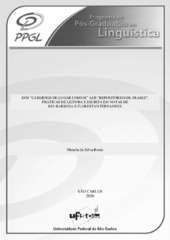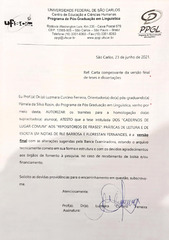| dc.contributor.author | Rosin, Pâmela da Silva | |
| dc.date.accessioned | 2021-06-01T11:13:26Z | |
| dc.date.available | 2021-06-01T11:13:26Z | |
| dc.date.issued | 2020-12-07 | |
| dc.identifier.citation | ROSIN, Pâmela da Silva. Dos "cadernos de lugar comum" aos "repositórios de frases": práticas de leitura e escrita em notas de Rui Barbosa e Florestan Fernandes. 2020. Tese (Doutorado em Linguística) – Universidade Federal de São Carlos, São Carlos, 2020. Disponível em: https://repositorio.ufscar.br/handle/ufscar/14329. | * |
| dc.identifier.uri | https://repositorio.ufscar.br/handle/ufscar/14329 | |
| dc.description.abstract | Since the invention of writing several techniques were created related to it and also reading. One of these was metaphorically described by Seneca in his Epistles. According to this philosopher’s understanding, reading and writing can be compared to the “bees”’ work, which collect pollen, from flower to flower, to make honey. Similarly to the bees’ pollen collecting, readers read and select the best texts and posteriorly the best phrases from such texts, gathering and regrouping them into notebooks. Thus, having their readings’ best “material” at hand, those readers could make the good quality “final product”, as their own written texts or oral speeches. In the long term, many were the subjects of different cultures that dedicated themselves to this task of establishing procedures and guidelines, as well as using these procedures related to text reading and phrase collection aiming to produce other texts, oral or written, for distinct purposes, being those texts either from the same genre and field of those where phrases were collected, or very distinct. In this thesis, we dedicate ourselves to analyze and describe some specificities in the appropriation of this reading and writing technique, by relevant brazilian intellectuals, from the second half of 19th century and first half of 20th century, namely, the jurist Rui Barbosa and sociologist Florestan Fernandes, as evidenced in their “notebooks”. To compose our notes corpus from these two intellectuals, we resorted to the collections “Fundação Casa de Rui Barbosa” and “Fundo Florestan Fernandes”, which get together documents, works and objects from these intellectuals. We selected, from their collections, 3 (three) notebooks from each author, all classified and available in the “produção intelectual” series. For that material’s analysis, we lean on Discourse Analysis and Cultural History’s principles and concepts. As any other cultural object, these notebooks point to discourses and representations that are in their production’s origin and determination of existence's cultural conditions. Rui Barbosa and Florestan Fernandes are subjects from a time-space and consequently are subject to the discourses and representations shared with their contemporaries. Those representations have a history, are socially and culturally determined by what the subjects know, believe, enunciate and practice. The way they read, select phrases, preserve them, collect and classify them, how they write their texts and constitute their works is greatly due to discourses and representations about what is reading, writing, what is to be an intellectual, writer, author in their time and in our society. Because of this reason, in spite of the similarities they present, these intellectuals differ in the technique’s usage and the ends and usages in their end-texts. One essential difference between them lies in the support given by themselves to those annotations: Rui Barbosa prefers loose pages; Florestan Fernandes the notebooks. Also, we observed that Rui Barbosa is “less organized”, more speculative, more literary in his phrase selection and how these are collected; Florestan Fernandes is “more organized”, more systematic, more didactic with this legacy. | eng |
| dc.description.sponsorship | Fundação de Amparo à Pesquisa do Estado de São Paulo (FAPESP) | por |
| dc.language.iso | por | por |
| dc.publisher | Universidade Federal de São Carlos | por |
| dc.rights | Attribution-NonCommercial-NoDerivs 3.0 Brazil | * |
| dc.rights.uri | http://creativecommons.org/licenses/by-nc-nd/3.0/br/ | * |
| dc.subject | Leitura e escrita | por |
| dc.subject | Seleção e citação de frases | por |
| dc.subject | Cadernos de notas | por |
| dc.subject | Rui Barbosa | por |
| dc.subject | Florestan Fernandes | por |
| dc.subject | Reading and writing | eng |
| dc.subject | Phrases collection and referencing | eng |
| dc.subject | Notebooks | eng |
| dc.title | Dos "cadernos de lugar comum" aos "repositórios de frases": práticas de leitura e escrita em notas de Rui Barbosa e Florestan Fernandes | por |
| dc.title.alternative | From "commonplace notebooks" to "phrase repositories": reading and writing practices from Rui Barbosa and Florestan Fernandes notes | eng |
| dc.type | Tese | por |
| dc.contributor.advisor1 | Ferreira, Luzmara Curcino | |
| dc.contributor.advisor1Lattes | http://lattes.cnpq.br/4849994635754652 | por |
| dc.description.resumo | Desde a invenção da escrita foram criadas várias técnicas relativas a essa prática e à leitura. Uma delas foi descrita metaforicamente por Sêneca em suas Epístolas. Para o filósofo, a leitura e a escrita poderiam ser comparadas ao trabalho “das abelhas”, que coletam o pólen, de flor em flor, para a fabricação do mel. De modo similar à coleta do pólen pelas abelhas, os leitores leriam e selecionariam os melhores textos e posteriormente as melhores frases desses textos, recolhendo-as e reagrupando-as em cadernos. Assim, tendo à mão o melhor “material” de suas leituras, esses leitores poderiam fabricar o “produto final” de qualidade, sob a forma de seus próprios textos escritos ou discursos orais. Na longa-duração, diversos foram os sujeitos de diferentes culturas que se dedicaram a essa tarefa de estabelecer procedimentos e orientações, assim como de se valer desses procedimentos relativos à leitura de textos e à coleta de frases com a finalidade de produzir outros textos, orais ou escritos, para finalidades distintas, fossem esses textos do mesmo gênero e campo daqueles em que se coletou frases, fossem textos bastante distintos. Nesta tese, nos dedicamos a analisar e a descrever algumas especificidades ne apropriação dessa técnica de leitura e escrita, por parte de intelectuais de relevo no Brasil, da segunda metade do séc. XIX e da primeira do séc. XX, a saber, o jurista Rui Barbosa e o sociólogo Florestan Fernandes, tal como indiciada em seus “cadernos de notas”. Para a composição de nosso corpus de notas desses dois intelectuais, recorremos aos acervos “Fundação Casa de Rui Barbosa” e ao “Fundo Florestan Fernandes”, que reúnem documentos, obras e objetos desses intelectuais. Selecionamos, de seus acervos, 3 (três) cadernos de notas de cada autor, todos classificados e disponíveis na série “produção intelectual”. Para a análise desse material, nos apoiamos em princípios e conceitos da Análise do Discurso e da História Cultural. Como todo e qualquer objeto cultural, esses cadernos indiciam discursos e representações que estão na origem de sua produção e na determinação das suas condições culturais de existência. Rui Barbosa e Florestan Fernandes são sujeitos de um tempo-espaço e consequentemente estão sujeitos aos discursos e às representações que compartilham com seus contemporâneos. Essas representações têm uma história, são sociais e culturalmente determinantes daquilo que os sujeitos conhecem, creem, enunciam e praticam. A forma como leem, selecionam frases, as preservam, as colecionam e as classificam, o modo como escrevem seus textos e constituem sua obra se deve em grande medida a discursos e representações acerca do que é a leitura, a escrita, do que é ser intelectual, escritor, autor em seu tempo e em nossa sociedade. É por essa razão que, apesar das semelhanças que apresentam, esses intelectuais se diferenciam quanto ao emprego da técnica e das finalidades e empregos em seus textos-fim. Uma diferença essencial entre eles se encontra no próprio suporte que destinaram para essas anotações: Rui Barbosa prefere as folhas soltas; Florestan Fernandes os cadernos. Além disso, observamos que Rui Barbosa “é menos organizado”, mais especulativo, mais literário em suas escolhas de frases e no modo como elas são colecionadas; Florestan Fernandes é “mais organizado”, mais sistemático, mais didático com esse legado. | por |
| dc.publisher.initials | UFSCar | por |
| dc.publisher.program | Programa de Pós-Graduação em Linguística - PPGL | por |
| dc.subject.cnpq | LINGUISTICA, LETRAS E ARTES::LINGUISTICA | por |
| dc.description.sponsorshipId | FAPESP: 2016/00467-2 | por |
| dc.publisher.address | Câmpus São Carlos | por |
| dc.contributor.authorlattes | http://lattes.cnpq.br/5846619832430283 | por |


